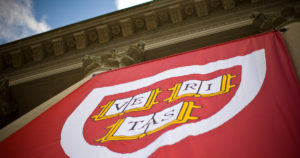By Alex Pinsk || Assistant Opinion & Editorial Editor

We rank schools. We discuss Harvard like it is the best of the best, as though if you end up there, you will become the most successful human being. We portray Ivy League education as the highest and most ideal route; but being accepted at one seems to be our society’s skewed version of success. Why do we have these notions? Why do we assume that those who attend a school with a lower acceptance rate are automatically higher-achieving people?
From a young age, we hear about Ivy League schools because those are the schools that, most often, show up in books, movies, and TV shows. I know I personally watched Gilmore Girls growing up, and throughout the series we hear about the main character’s aspirations to attend Harvard. After being accepted at Princeton, Yale, and Harvard, she ultimately picks Yale. Thus, I grew up knowing the names of those three schools before I knew the names of any others. Naturally, with such a competitive society, most people do hear about and epitomize Ivy Leagues from a young age. More often than not, these opinions come from the schools’ acceptance rates. The idea is that the lower the acceptance rate, the better the school. Because, naturally if a school accepts fewer people because there are thousands of applications, than those whom it accepts must all be the smartest of smartest. The lower the acceptance rate, the better the school. At least, that is what people think.
The truth is that comparing a university like Harvard to a liberal arts college like Franklin & Marshall is like comparing apples and oranges. People decide to go to an Ivy League university for one set of reasons and a liberal arts school for completely different set of reasons. In other words, the ranking of the school says nothing of the education that one might receive there. Liberal arts schools are known for their interdisciplinary learning and their small class sizes. They are known for strong student-professor relationships as well as a smaller sized student body. Universities are known for their research opportunities, their large size, and the fact that they have graduate students on campus.
Why are we enamored by schools in which many first and second-year classes are taught by teaching assistants rather than professors? Why do we admire, to such a high degree, universities that only allow graduate students to do research? The answer is in the name. If someone has heard of the school, then they probably just assume it is better. Likely, most people have not heard of some of the schools in the country with the most dedicated students and passionate professors, solely due to the size of the institution and the historic reputation of the school perpetuated without depth by culture and society.
F&M is a fantastic school. If you are here, you know that. The truth is that no matter the size of the school, the type of school, or the location of the school, it is really the quality of the education you receive there that makes or breaks the experience. Be it a small liberal arts college, a large state university, or an Ivy League institution, if you work hard and seek out the resources, you will succeed.
However, small class sizes, dedicated professors, and undergraduate research opportunities are just a few of the elements that distinguish liberal arts colleges and most namely, Franklin & Marshall.
First-year Alex Pinsk is the Assistant Opinion & Editorial Editor. Her email is mpinsk@fandm.edu.